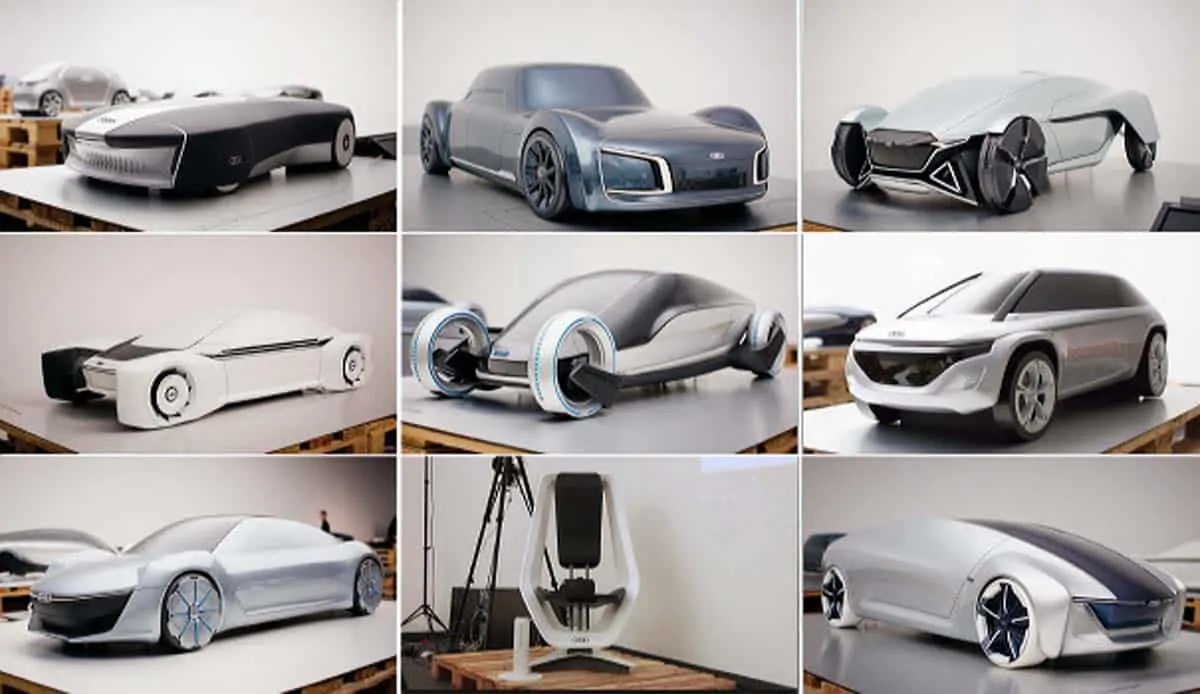Audi’s Design Universe is an exchange between the premium brand’s current designers and the designers of tomorrow. It’s a think tank for young designers as well as a resource for the brand. This year design students from four European universities were asked to develop vehicles for the German brand that aligned with current and emerging trends.
“Design is always about changing the perspective,” says Audi design chief Marc Lichte. “With Audi Design Universe we have [built] a platform for young designers to show us how they interpret our brand and how they imagine cars of tomorrow.”
Though the students’ ideas for the future of Audi had to interpret the brand’s values, each project had its own individual and unique take. There were electric cars with spacious and minimalist interiors; disappearing steering wheels that retract into dashboards for a semi-autonomous driving; and purely autonomous vehicles that reinterpret the meaning of ‘driving pleasure’ through augmented and virtual reality.
These are the concepts designers created.
Audi Quantum

Virtual reality was part of the concept proposal created by students Andrew Marshall, Michael Hofbauer and Ankur Singh Sengar from Scuola Politecnica di Design in Milan. Called the ‘Audi Quantum’ (as in quantum leap) the futuristic sedan concept is aesthetically appealing and technologically advanced. The car scans the driver’s retina when approaching and immediately adjusts the interior color and seating layout to suit the user’s preferences. The car then approaches the driver to grant them the best access possible – a task that’s facilitated thanks to the 360-degree rotating wheels, like those found on an office chair.
Audi Cruiser

Design students Ioan Caius Ferenczi and Kamil Khabiev were inspired by the Graz Art Museum (built as part of the European Capital of Culture celebrations in 2003), viscous liquids and the Auto Union Type C Streamliner in the creation of the Audi Cruiser concept. The design’s emphasis on the tire recalls the 1930s racecar while its rounded shapes highlight the concept’s more elegant side. The Cruiser’s seats also extend outward to grant easier ingress into the cabin.
Audi DreamWalker

Space exploration was a great source of inspiration for Cesar Estrada and Tiago Nunes, creators of the DreamWalker. The concept imagines a vehicle for the year 2045, when space travel will be an exclusive hobby. While the formal language of space shuttles inspired the concept’s exterior design, the defining Audi single-frame grille remains an unchanged brand identifier even in the distant future.
Audi Type 53

The Audi Type 53 is Maks Domanski and Mirko Pavan’s futuristic development of the Auto Union Type 52 from 1934, a classic racecar designed by Ferdinand Porsche that was never built. The gently sloping roof in particular is reminiscent of the classic racecar, but while a gasoline engine was meant to fuel the Type 52, Domanski and Pavan’s future vision is propelled by electricity sourced from in-wheel motors.
Audi Artec

Inflatable metal — as used in the Plopp Chairs by Polish designer Oskar Zieta — inspired design students Lukasz Myszynski, Vartan Padaryan and Tomasz Prygiel to create the Audi Artec concept. The vehicle’s single volume employs the innovative technology to enable the customer to feel as if they’re traveling through airspace. The concept’s wheels change color depending on the driver’s mood.
The Iconic Seat
![]()
The Iconic Seat was presented by group of students from TU Dresden. The future user dons data glasses and becomes fully immersed in a virtual environment that adapts to him or her. If the passenger wants to feel as if they’re by the sea, gills within the chair’s frame open by means of a shape memory wire and the sound of waves lapping on shore spreads quietly through the cabin. The designers even included a way to simulate smell. The car adapts not only to mood and desires of the occupants, it’s a car that creates an experience and appeals to all senses.
Audi Move

The design of sailboats — and catamarans in particular — inspired Maximilian Schneider and Romain Caillet to create the Audi Move concept. A silver cylinder, reminiscent of a sail mast, dominates the interior, while the display for navigation and Internet applications is designed in the style of a compass.
Audi Atlante

The Atlante is a concept we’ve previously featured on our pages. Billed as a pioneering vehicle developed to enable its users to discover new things, Alessandro Ren, Nicola Siepi, Alvaro De Almeida and Giacomo Vagge envisioned a vehicle that revolves around space exploration. The car features a deconstructive aesthetic on its exterior surfaces, which are made from metal and fabric. An opening in the top of the vehicle grants access to the interior, where driver and front passenger enter into a tailor-made space suit perfectly fitted on the human body.
Audi Sodalis

Autonomous driving will be commonplace in the future. Luca Antonioli, Filippo Doria and Alberto Ponti therefore envisioned a car users have to drive — at least part of the time. The Audi Sodalis features three screens to relay all information to the driver, placed on either side of him. When in autonomous mode, the car has large OLED screens to ensure wellbeing and entertainment of passengers.


